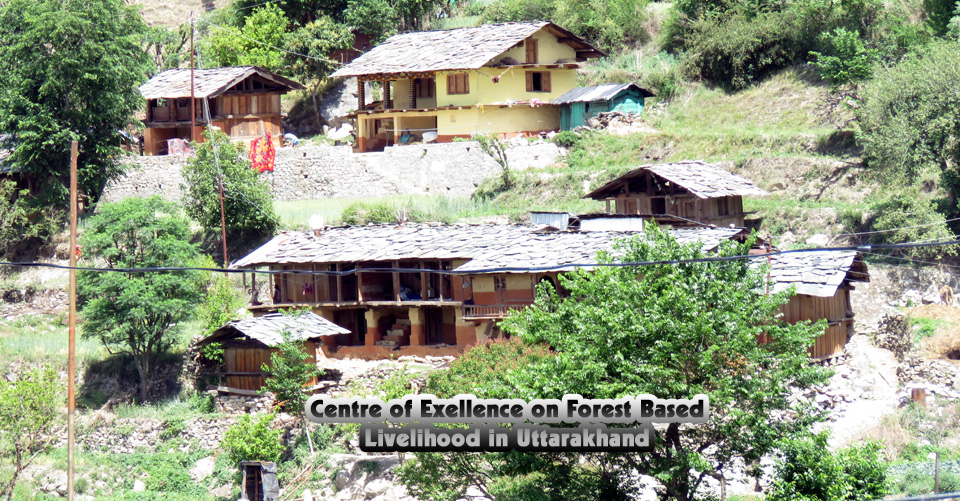Center of Excellence

 Uttarakhand's forests have been an essential part of the state development and nearly 80% people are directly or indirectly dependent on forests either for their sustenance or subsistence. Forests provide fodder, fuelwood, many wild foods, construction material and medicines for humans and cattle. Besides this forests also create microclimate for cultivation of several crops of the hill. Thus forests and their produce provide substantial livelihood for forest fringe areas. Non wood forest products (NWFPs) mainly medicinal plants and bamboos are gaining importance in bringing better livelihood opportunities. A step in this direction was taken by Ministry of Environment, Forest & Climate Change, GOI along with Uttarakhand State Council for Science & Technology (UCOST) Dehradun through establishment of a Centre of Excellence on Forest based Livelihood to carry out the necessary study on the subject. A very first of its kind in the state, the COE delves on issues related to forest based products and livelihood and is going to serve as a knowledge and study centre for forest based resources.
Uttarakhand's forests have been an essential part of the state development and nearly 80% people are directly or indirectly dependent on forests either for their sustenance or subsistence. Forests provide fodder, fuelwood, many wild foods, construction material and medicines for humans and cattle. Besides this forests also create microclimate for cultivation of several crops of the hill. Thus forests and their produce provide substantial livelihood for forest fringe areas. Non wood forest products (NWFPs) mainly medicinal plants and bamboos are gaining importance in bringing better livelihood opportunities. A step in this direction was taken by Ministry of Environment, Forest & Climate Change, GOI along with Uttarakhand State Council for Science & Technology (UCOST) Dehradun through establishment of a Centre of Excellence on Forest based Livelihood to carry out the necessary study on the subject. A very first of its kind in the state, the COE delves on issues related to forest based products and livelihood and is going to serve as a knowledge and study centre for forest based resources.
Most of the rural population in the hills of Uttarakhand either survives on subsistence agriculture or migrates to other parts of the country for employment, leaving their lands untilled and fallow. The state faces the challenge of promoting livelihoods to retain people through local employment and income generation and to enhance their quality of life. Hill development remains an uphill challenge as out-migration of local peoples continues from the highland hinterlands. In this context this project was proposed to focus attention on compiling the database of the contribution of the forest and grassland resources as livelihood opportunities in Uttarakhand state as pilot project, and particularly to mainstream the concept of sustainable mountain development of this particular Himalaya region into the planning framework.
To become a resource and knowledge centre on forest based livelihood and contribute towards sustainable livelihood opportunities in the State.
- To collect all the available data on forest based produce with focus on non-timber products like medicinal plants and bamboo and to create a clearing house for the same.
- To interact with people through focused group discussion (FGD) and to estimate their dependence on forests for their livelihood.
- To do value and supply chain analysis for different forest products.
- To create a resource directory of various government and non government organisations, private institutes and experts working in the area of forest livelihood.
- To conduct socio-economic analysis and estimate cultural dependence of the forest fringe villages on forestry.
Rural population of Uttarakhand depends a lot on forest resources for their food, fuel and fodder requirements. These resources provide not only livelihood but also income generating opportunities for them. COE thrives to generate datasets on forest based livelihood and income generating opportunities. This will help to calculate the dependence of forest fringe dwellers on these resources and intervene in order to improve quality of life. COE mainly targets on forest based produces for livelihood opportunities such as medicinal plants and bamboos.
Medicinal plants:
Uttarakhand state is the hub of medicinal plant species due to wide altitudinal variation, different habitat types, and varying microclimatic conditions. The state has nearly 700 species of medicinal plants which find usage in folk and documented systems of medicine like Ayurveda, Siddha, Unani and Homoeopathy. There are some medicinal plants such as neem, bhringraj, gokhru, tulsi, dhatura etc. which enjoy open harvest (from forests) status. Few other plants such as Hattajari, atis, kutki, bach, giloy, sarpgandha etc. are totally banned to be exploited from forests and their demand is to be met through cultivation by the farmers. Some other species are allowed to be harvested in a sustainable manner e.g. harad, bahera, bael, amla, amaltas, tejpat etc. Medicinal plants are not only a major resource base for the traditional medicine & herbal industry but also provide livelihood and health security to a large segment of Indian population.
Bamboos:
Bamboos regarded as the poor man's timber and have been associated with human's civilisation since ages. There are mainly eight bamboo species growing naturally in Uttarakhand; four are of thick bamboo and remaining four are thin species known as ringals. The bamboo species viz. Dendrocalamus strictus, D. Somdeviii, D. Patellaris and bambusa bambos grow between 300-1500 msl and are used for making paper and diverse household items. The ringal species viz. Drepanostachyum falcatum, Thamnocalamus pathiflorus, T. Jaunsarensis and himalayacalamus falconeri grow between 1500-3500 msl and are commonly used for making baskets, mats, flowerpots and other products. Bamboos play an important role in rural economy by providing subsistence activity, employment generation and household income.
Others:
Few other forest products also provide large livelihood opportunities in the state. They include wild edibles such as fungi, berries, nuts and flowers for human and fodder for cattle. They also include fuel wood, fibres, seeds, honey, leaves, bark, resins, gums and many other products obtained from forest. Keeda jadi, a caterpillar fungus found at an altitude of 3500 msl, due to high medicinal value, has greatly enhanced the economic status of the collectors of Pithoragarh, Chamoli and Bageshwar districts. Jhula, a lichen is a source of livelihood due to its use in perfumery and dye making. Some multi purpose species like bhimal and Khadik are a part of rural culture in hilly regions and indispensable for carrying out their day to day activities.
- Database of forest based livelihood in Uttarakhand.
- Information regarding socio-economic status of the people dependent on forests for their livelihood.
- Resource and information centre on forest based livelihood in Uttarakhand.
- Information generated will be helpful in sustainable forest management and in exploring livelihood opportunities of the State.
- Prof(Dr) Durgesh Pant , Director General, UCOST
- Dr Ashutosh Mishra, Sr. Scientific Officer, UCOST
- Dr Rommila Chandra, Scientific Officer, UCOST
- Dr Monika Negi, Senior Scienitst, COE
- Mr Siddharth Napalchyal, Scientist, COE

